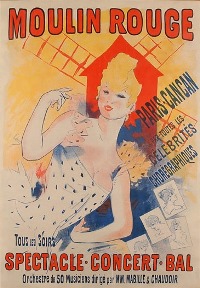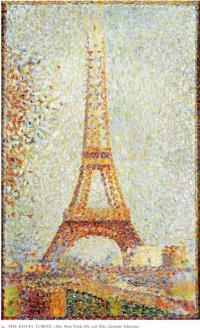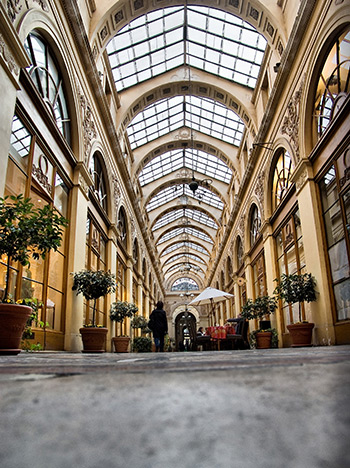
FROM FOURIER TO FUTURISM(S)
A Walking Tour Through the Streets of Modernist Paris
FL 3320 European Studies,
Spring 2017, Module #2, MWF 12:30-1:30, EH#105
--
Office MW 10:30-11:30, or by appointment, EH #455
The Price of Admission = Our Readings -- TBA :)
- Walter Benjamin, "Paris, Capital of the Nineteenth Century"
- William R. Everdell, "The Century Begins in Paris, Modernism on the Verge -- 1900"
- (a) Guillaume Apollinaire, selections from
Calligrammes, or
(b) Filippo Tomasso Marinetti, "The Founding and Manifesto of Futurism," or
(c) "Speed," chapt. 5 of Stephen Kern, The Culture of Time and Space I , II, or related text - Film screening, Jean Vigo, À Propos de Nice or Zero for Conduct (TBA)
Scheduled Walking Tours, Detours, and Short-Cuts
- (1)
Politics and Political Theories in 19th-century
France/Paris --
Walter Benjamin
Liberty, unless enjoyed by all, is unreal and illusory.... To secure liberty a Social Order is necessary which shall
|
Most of the images of Paris that belong to our repertory of cultural stereotypes
-- from impressionist painting to the main boulevards,
to café life -- "derive from Haussmann’s transformation of Paris. The intention of Napoleon III’s protégé was clear:
a total rationalization, cleaning and opening of the city, was necessary for the circulation of the thousands of people pouring into Paris
by rail every day, as well as to establish a well-organized civic center in the Île de la Cité.
- Patrizia Lombardo, "Modern Metropolis...."
-
(2) Expositions Universelles, Technology, and Modern Consumerism
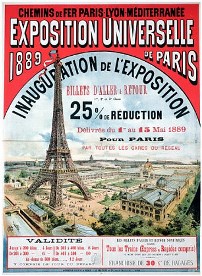 |
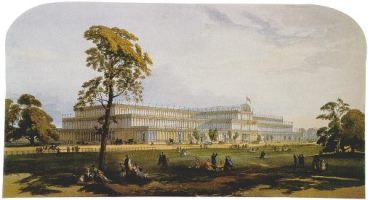 |
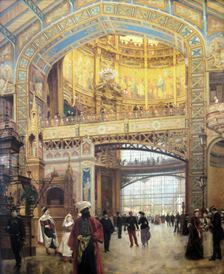 |
| Exposition Universelle 1889 | The Great Exhibition at Crystal Palace, London, 1851 |
Gallerie des Machines, Exposition Universelle 1889 |
On entering the building for the first time, the eye is completely dazzled by the rich variety of hues which burst upon it on
every side; and it is not until this partial bewilderment has subsided, that we are in a condition to appreciate as it deserves
its real magnificance and the harmonious beauty of effect produced by the artistical arrangement of the glowing and varied hues
which blaze along its grand and simple lines...
Forming the centre of the entire building rises the gigantic fountain, the culminating point of view from every quarter of the building;
whilst at the northern end the eye is relieved by the verdure of tropical plants and the lofty and overshadowing branches of forest trees...
the objects which first attract the eye are the sculptures, which are ranged on every side; some of them of colossal size and of unrivalled beauty...
We have here the Indian Court, Africa, Canada, the West Indies, the Cape of Good Hope, the Medieval Court, and the English Sculpture Court...
Birmingham, the great British Furniture Court, Sheffield and its hardware,the woollen and mixed fabrics, shawls, flax, and linens, and printing and
dyeing... general hardware, brass and iron-work of all kinds, locks, grates... agricultural machines and implements... the mineral products of
England... the cotton fabric and carriage courts, leather, furs, and hair, minerals and machinery, cotton and woollen power-looms in motion...
flax, silk, and lace, rope-making lathes, tools and minerals, marine engines, hydraulic presses, steam machinery, Jersey, Ceylon, and Malta
with the Fine Arts Court behind them; Persia, Greece, Egypt, and Turkey, Spain, Portugal, Madeira and Italy, France, its tapestry, machinery,
arms and instruments, occupying two large courts; Belgium, her furniture, carpets and machinery; Austria, with her gorgeous furniture courts and
machinery furniture, North of Germany and Hase Towns; Russia, with its malachite doors, vases and ornaments, and the United States, with its
agricultural implements, raw materials etc.
—Catalogue of the Exhibition (Art Journal), 1851
To him, the dynamo itself was but an ingenious channel for conveying somewhere the heat latent in a few tons of poor coal hidden in a dirty engine-house carefully kept out of sight; but to Adams the dynamo became a symbol of infinity. As he grew accustomed to the great gallery of machines he began to feel the forty-foot dynamos as a moral force, much as the early Christians Cross. The planet seemed less impressive, in its old-fashioned, deliberate, annual or daily revolution, than this huge wheel, revolving within arm’s-length at some vertiginousspeed, and barely murmuring... while it would not wake the baby lying close against its frame. Before the end, one began to pray to it; inherited instinct taught the natural expression of man before silent and infinite force.
- Henry Adams, "The Dynamo and the Virgin" (Great Exposition in Paris, 1900)
-
(3) Case # 1: Charles Baudelaire, Of Flâneurs, Dandies, and the Bourgeoisie
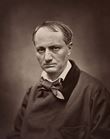 |
When the urban spectacle dazes more than it dazzles, the flâneur comes to resemble an exiled figure who has not chosen to ramble about the city but is compelled to do so. Originally a stroller able to quit the city and return home, he becomes over the course of the 19th-century a drifter without a home. Once a celebrant of urban enchantments, the flâneur at mid-century exposes not only the uncertainty and anomie that attend life in the modern city but also and more especially a failure that threatens the creative enterprise. - Priscilla Parkhurst Ferguson, "The Flâneur...." |
For the perfect flâneur, for the passionate spectator, it is an immense joy to set up house in the heart of the multitude, amid the ebb and flow of movement, in the midst of the fugitive and the infinite.... the lover of universal life enters into the crowd as though it were an immense reservoir of electrical energy.... He is an 'I' with an insatiable appetite for the 'non-I'
- Charles Baudelaire, "The Painter of Modern Life"
I am convinced that the ill-applied developments of photography, like all other purely material developments of progress, have contributed much to the impoverishment of the French artistic genius.... [L]et it be the secretary and clerk of whoever needs an absolute factual exactitude.... But if it be allowed to encroach upon the domain of the impalpable and the imaginary, upon anything whose value depends solely upon the addition of something of a man's soul, then it will be so much the worse for us!
- Charles Baudelaire, "The Salon of 1859"
-
(4) Futurism(s) avant and apres la lettre (Everdell)
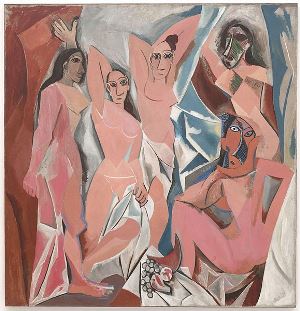 |
In the early months of 1907, a twenty-five-year-old Picasso set out to remake the history of art. In Paco Durrio’s
old upstairs studio in the Bateau-Lavoir, he drew and painted studies of women far into the night. A candle flickered.
By the wall stood his new blank canvas, eight feet high, sized and lined for a succPs de scandale and a frontal assault
on immortality. Everything in art would go into it; and (such was the hope of the most ambitious painter in Paris)
all subsequent art would grow out of it. It would be called Les Demoiselles d’Avignon (Avignon young ladies),
and the first people to see it would call him mad. - W. B. Everdell, The First Moderns
|
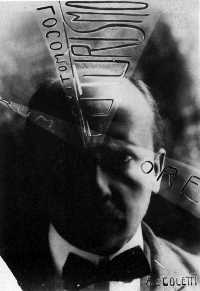 |
We declare that the splendor of the world has been enriched with a new form of beauty, the beauty of speed. A race-automobile adorned with great pipes like serpents with explosive breath.... a race-automobile which seems to rush over exploding powder is more beautiful than the Victory of Samothrace..... We will glorify war - the only true hygiene of the world - militarism, patriotism, the destructive gesture of anarchist, the beautiful Ideas which kill, and the scorn of woman. - Filippo Tomasso Marinetti,
"The Foundation and Manifesto of Futurism," |
|
(5) Bedazzling Paris with Dizzying Dances -- Les Ballets Russes & Igor Stravinsky Had Serge Diaghilev never lived, it is safe to say, the history of 20th-century ballet would have been very different. . . . Without Diaghilev, who would have heard of the myriad Russians who joined the vast ballet exodus set in motion by his company? Without Diaghilev, would Stravinsky have composed Le Sacre du Printemps, or Ravel Daphnis and Chloe? Would Nijinsky have choreographed L’Apres-midi d’un Faune - or any ballet, for that matter? Would Balanchine have found his true path with Apollo? Would Picasso or Matisse have designed for the stage? Were it not for Diaghilev, would ballet during the twenty years his company existed - from 1909 to 1929 - have become the most exciting of the era’s performing arts, a magnet for artists of genius and meeting ground for a sophisticated, international elite? To raise these questions is involuntarily to know the answer: probably not. — Lynn Garafola, "The Legacy of Diaghilev’s Ballet Russes" |
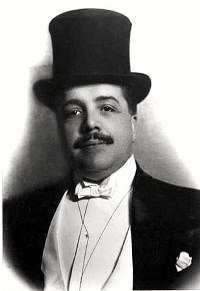
|
Sergei Diagilev 1917
(6) Americans in Paris -- and the French in New York
[The Armory Show] was, perhaps, the first great media event in art. But beyond that... it was a coherent and fairly comprehensive, even "scholarly" presentation of the development in "modern art." The exhibition was really two in one, with the radical foreign works imbedded in a great, somewhat anomalous mass of American art. The intention had been to show the most advanced work in this country as well as abroad, but what was considered progressive here had little relation to the revolutionary art of Europe. As a result, although our critics "thanked the Lord" for "American sanity" and "honest craftsmanship," the Europeans stole the show.
- Milton W. Brown, "The Armory Show and Its Aftermath" in 1915
(7) Case # 2: Guillaume Apollinaire, An Exemplary Bard of Modernism
| You are weary at last of this ancient world
Shepherdess O Eiffel tower whose flock of bridges bleats at the morning You have lived long enough with Greek and Roman antiquity Here even automobiles look old |
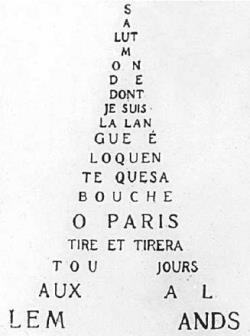 Guillaume Apollinaire, Calligrammes |
Central among [Apollinaire’s] aesthetic ideas was the notion that the modern work of art must adequately reflect the global nature of contemporary consciousness. In the conditions of modern life man has achieved totality of awareness: through worldwide communications he is aware of what is happening in New York as in Paris; through newspapers, radio, and the cinema his imagination is stimulated by a constantly changing stream of information and ideas; in the streets and cafés his senses are assailed by a kaleidoscopic multiplicity of sights, sounds, and sensations. To be able to mirror such a multiple form of consciousness the work of art had to abandon linear and discursive structures, in which events are arranged successively, in favor of what Apollinaire called simultaneity: a type of structure that would give the impression of a full and instant awareness within one moment of space-time.
- S. I. Lockerbie, "Introduction" to Calligrammes
(8) Case # 3: Man With a Movie Camera--Jean Vigo, the Dialectics of Seeing, and the New Left
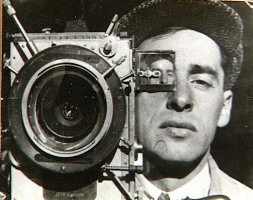
Jean Vigo Man with a Movie Camera 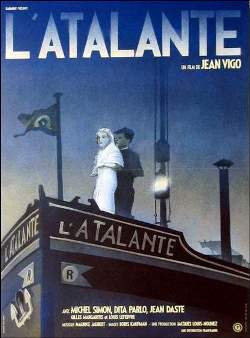 |
Even among cinema’s legends, Jean Vigo stands apart. The son of a notorious anarchist, Vigo had a brief but brilliant career making poetic, lightly surrealist films before his life was cut tragically short by tuberculosis at age twenty-nine. Like the early experimental works of his contemporaries Jean Cocteau and Luis Buñuel, Vigo’s films refused to play by the rules. His small body of work includes À propos de Nice, an absurdist, rhythmic slice of life from the bustling coastal city; Taris, an inventive short portrait of a swimming champion; Zéro de conduite, a radical, delightful tale of boarding-school rebellion that has influenced countless filmmakers; and L’Atalante, widely regarded as one of cinema’s finest achievements, about newlyweds beginning their life together on a canal barge. These are the witty, visually adventurous works of a pivotal film artist. Vigo is often considered the patron saint of French (avant-garde) film, with a distinguished prize named in his honor. |
User-friendly Suggestions for Assignments
I suggest you write a 3-6 page informal paper -- call it an essay, a reflective journal or notebook entry, a personal mediation, you name it -- on any one of the larger, international issues we'll explore in our discussions. Make sure you consult some sources listed below and/or some substantial web sites as you develop your expertise and articulate your thoughts. Please develop a topic for which you have a certain affinity/interest (perhaps based in part on your knowledge of a European country or culture), and please know as well that your writing does not necessarily need to advance a thesis; an exploratory informal paper in which you grope or write (yourself) toward something may be just a meaningful. If at all possible, try to integrate our primary readings (Benjamin, Everdell, etc.) with your additional research. Possible topics:
- The effects of (Parisian) World's Fairs on the idea of consumerism and a multicultural and/or imperial Europe.
- Paris as Mecca for Russian artists (or artists from other parts of the world)? Why the attraction? What were the enabling conditions?
- Vienna vs. Paris: a change of guards? A new synergy?
- a close study of a work of art -- such as a ballet, a painting, a work of literature, a sculpture -- in the context of Paris, Europe, and the artist's self-definition (as European and/or Modernist ' Picasso, Stravinsky, Apollinaire . . .
- The relationship between modern art and politics, demonstrated through a close look at a work of choice?
- The relationship(s) between modern art, science, technology, speed (Seurat, Picasso, Italian Futurism, The Lumiére brothers, etc.)
- Benjamin's notion of successive technological epochs and the media ecology of modernism---in other words, what are the interactions between the various forms/schools of painting, photography, film, etc.
- The city and modernism
- The Dreyfus Affair (or a related incident of racial discrimination) in the context of Europe's ongoing self-(re)definition--- in the late 19th century as well as now . . . .
- The relationship of speed and nationhood/Europeanness
- French Film in the 1920/30s -- Jean Vigo, Jean Renoir. . .
- French Surrealism, . . . . Dadaism . . . And the list goes on.
Due Date: on the Wednesday following our last class session, which would make it 29 March 2017. Please keep in mind that I'd be happy to talk to you about your papers and projects in progress. Message: let's talk . . .
